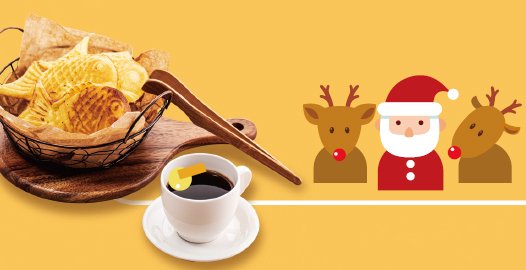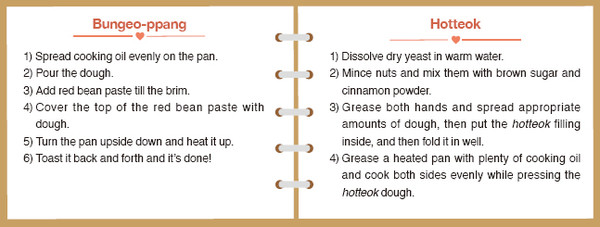: Prepare One Thousand Won in Your Heart (*won: KRW)
Recently, as the weather is becoming increasingly cold, there are many food trucks selling winter snacks on the streets. As people became familiar with the scene of winter snacks being sold on the streets during this season, these winter snacks became a winter tradition. There are many types of street snacks in Korea, and over the years, many new variations have been created by changing the toppings and sauces. For instance, only red bean paste and custard cream bungeo-ppang (carp bread, in English) were sold in the past, but in recent years, you can find various types of bungeo-ppang, such as cream cheese, sweet potato, pizza, and even kimchi bungeo-ppang. Similar to bungeo-ppang, in recent years, even hotteok (Korean-style pancake originated in China, in English) has been sold with various toppings and sauces, such as ice cream and cream cheese hotteok.

Bungeo-ppang
The history of bungeo-ppang began in Japan at the end of the 19th century. It is called domi-ppang (sea bream bread, in English) in Korean and taiyaki in Japanese. Segeiro Kobe, who ran a bakery in Japan during the 19th century, made bungeo-ppang with the idea of including precious fish cream into bread. If you look at the shape of a taiyaki, it looks similar to the bungeo-ppang. When it was recreated in Korea, it was transformed into the familiar type of bungeo-ppang that suits Korean sentiment.
Hotteok
Hotteok refers to the rice cake that barbarians ate. It was introduced in Korea with the arrival of the Chinese. When the Im-O Military Revolt broke out in 1882, the Qing Dynasty dispatched 3,000 troops to Joseon, and 40 merchants from the Qing Dynasty joined along. When the Qing Dynasty collapsed, they did not return to the mainland. The remaining merchants opened restaurants for a living and started selling food, such as dumplings and hotteok. They gradually altered the recipe to suit Korean tastebuds and sold it with grain syrup, honey, and brown sugar. This Korean-style hotteok was spread around the Chinese Embassy in Myeong-dong, Seoul, where Chinese residents gathered in the streets of Jongno.
Simple Recipe of Bungeo-ppang and Hotteok

Reporters from The UOS Times ate these winter street snacks and reviewed the taste.
Bungeo-ppang
• S: The red bean paste is so sweet and the bread is filled with sufficient filling. In particular, unlike red bean paste bungeo-ppang, custard cream bungeo-ppang is very soft.
• H: Bungeo-ppang’s dough and cream are soft, and the cream is not overly sweet, as I expected. It is crispy outside and juicy inside.
• K: It is the first bungeo-ppang that I ate this year. Therefore, it tastes more delicious to me and the texture is chewy.
• P: It is really sizeable. There are many red bean pastes, and it is not as sweet as I expected it to be.
Fish cake
• S: The texture is really chewy, and it melts my cold heart. I can taste familiar condiments.
• K: I think fish cake soup is more delicious when eaten during the cold winter.
Hobbang (steamed bun, in English)
• H: I can taste the flour, and it is not that spicy. I feel full after eating it.
• S: Did you buy this from a convenience store? It is not my style.
Such street snacks melt away the ice during the cold winter. When people walk around the streets in winter, eating fresh fish cakes or bungeo-ppang in warm snack trucks is one of the most interesting experiences that are exclusive to winter. Therefore, consider bringing along 1,000 KRW in your pocket. You MUST prepare 1,000 KRW in your heart since you don’t know when you will run into a snack truck on the street. It will be like an oasis in the desert.
Kim Na-yeong
kny0218@uos.ac.kr

